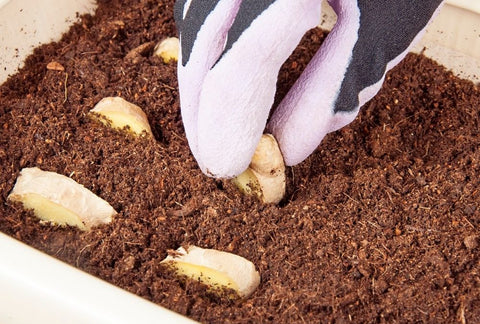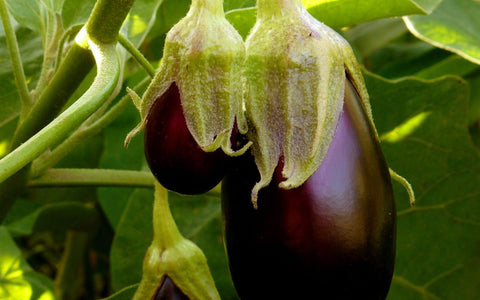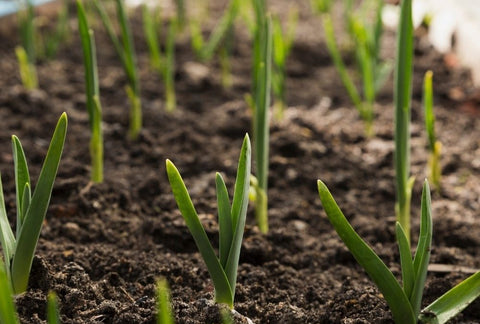Ginger has a versatile history – ancient Chinese used the root of ginger as a tonic to treat common ailments while Romans used it to make sweets.

Timing
Sprouts in 6-8 weeks. Harvest from Month 8+ on.

Part sun
Equivalent of 4+ hours of direct sun [DLI of 12+ mol/m²/day].

Care
Beginner-friendly & low maintenance.
Best Ginger Varieties to Grow Inside
There are many types of ginger, some are edible, some are used for ornamental purposes. Below is a quick guide on the top four most common ginger varieties:
Common
Edible
It is known for its aromatic and pungent rhizomes. It has significant medicinal and culinary uses.
AmazonKahili
Ornamental
Large dramatic foliage and showy, fragrant flowers make it a truly exotic tropical plant. However, it does not have many edible usages.
AmazonCrepe
Edible
Known for its crepe-paper like showy white flowers that emerge from reddish-burgundy spiraled inflorescences. Its flowers and buds are also edible.
AmazonTorch
Edible
It looks glorious with its big and vibrant flowers that appear in red, pink, or orange color. The whole plant is edible.
AmazonBest Setup for Ginger Plants
You’ll need:
Planter:
Ceramic Self Watering Planter (preferred) or pot that is at least 8″ / 1 gal.
Soil:
Standard Potting Mix
Plant Food:
Vegetable Blend. This should be high in phosphorus.
Grow Light:
A strong grow light that can give the equivalent of 4+ hours of direct sun [DLI of 12+ mol/m²/day].
Jump to: Our product recommendations
Preparing your Planter & Watering Schedule for Ginger
Ginger plants do well in moist soil conditions. If the soil dries out completely the roots will die back and it will be tough for the plant to recover. On the other hand, if the roots are exposed to standing water for too long, they can rot.
A Ceramic Self Watering Planter filled with a standard potting mix self-regulates to keep the soil at consistent moisture for your plant to thrive (and no watering guesswork for you).
To set one up:

- Fill up the planter with dry soil from the bag, gently tamping down the top.
- Dump the soil into a large mixing bowl and add water until the soil is moist, but not sopping wet (about ½ Cup)
- Mix in 1 tablespoon of the Vegetable Blend Plant Food.
If you are using a regular pot instead, it should be a little bit bigger (at least 8″ / 1 gal) and will need drainage holes to prevent it from being over watered. Let the top of the soil dry out between watering.
Starting your Ginger: Seed vs Propagate vs Nursery Plant
Ginger is easy to start from a ginger root. If you are feeling impatient – they’re also easy to propagate by dividing an established clump or buying a pot of them.
How to Plant Ginger Roots

Plant 2 sites in an 8″ / 1 gal container. In larger containers, space sites 6″ apart. For each site plant 1 rhizome (~1-inch piece of the root) 3 inches deep. Keep the soil warm (60-90°F, ideally 70°F). Sprouts typically appear in 7 weeks but can be as quick as 6 weeks or as long as 8 weeks depending on your conditions.
Propagating established bunches: How to divide Ginger
Ginger replicates underground – so if you’ve already got an established plant you love (or a friend does!) you can easily “clone” it by dividing the bunch. First, give it a good watering to loosen up the roots. Then pull the entire cluster out and gently tease the roots apart. That’s it!
How to Transplant Ginger

Live starter plants give you a big jump start on your first harvest. When you’re in a garden center – pick the bushiest plant available (tall and lanky ones will be weak growers) and give it a good inspection for pests. Leaves should be dark green without holes, spots, or curled edges. A best practice is to actually “quarantine” your plant for about a week after bringing it home to make sure it’s free and clear of ride-on pests.
Ensuring it’s pest and disease-free, it’s time to transplant your seedling into its final home.
- Remove some soil from its final planter – leaving enough space for the bottom of the seedling to be just higher than the soil surface.
- Hold on to the base of the stem with one hand, and turn the pot over while gently pulling the seedling. Giving the pot a few squeezes can help dislodge it.
- Place in its final container and fill around it with soil so that it’s tight, but not compacted.
Where to grow your Ginger plants
Out of all edible plants, Ginger plants have some of the lowest light needs – but they still need to be in a very bright place that gets at least 4+ hours of direct sunshine. While you might be lucky enough to have a bright windowsill that works, most of us need to use a grow light (especially during the winter). For an introduction to grow lights, head over to our post on grow lights for indoor gardeners. We’ve also got a buying guide for screw-in types, but to keep things simple in this guide, we’ll just provide directions for the 24W Screw-in Bulb by Sansi, which we think is a good middle-of-the-road option.

How bright should your grow light be?
Ginger plants need the equivalent of 4+ hours of direct sunlight [DLI of 12+ mol/m²/day] to grow their best. In order to provide an equivalent amount with a grow light, it needs to be pretty bright! The 24W Sansi bulb should be placed 9 inches away from the top of the plant. This will give your PPFD (the standard measure of brightness) of 500 μmol/m²/s.
How many hours per day do your Ginger plants need under a grow light?
Ginger plants are known as “short-day,” meaning they’ll switch their efforts to making seeds if they sense over 12 hours of darkness. We want to keep them in an earlier stage so we can keep harvesting the leaves, so we recommend setting up a timer to leave it on for at least 14 hours per day.
Ginger Plants Grow Faster in Warmer Temps
Ginger plants are called “warm-weather crops” and like temperatures right around 75°F. They will grow fine in conditions between 50 and 80°F. Most homes are in a good range – and a south-facing sunny window can help get a plant the extra heat if needed.
Week 6-8: Check for Sprouts
You could see seedlings in as little as 6 weeks (though 7 weeks is more typical). If it’s been 8 weeks and you still don’t have any sprouts, it’s likely that your setup is too cold.
Month 3: Check Your Seedlings
There’s no need to thin Ginger, but you should check on your seedlings’ progress to make sure you’ve got enough light. They should be about 2 inches tall by the end of Month 3. If they aren’t you likely need a bit more light.
Month 8+: How to Harvest Ginger
Dig up the roots and just cut off a little piece. As long as you leave 2/3rds the root the plant will continue to grow and give you ginger for years to come.
Year 10+: End of Life
If you don’t dig up the bulbs, ginger roots will replicate underground. In its second year, the first root will flower – they’re edible and should be harvested right after they open.
Shop This Blog
The right supplies can take the guesswork out of caring for your plants – and turn care from a daily to weekly routine. Through our grow tests, we’ve found these products to produce the best indoor Ginger (and also have simple maintenance). Plants are adaptable and can grow in many different conditions, so they are by no means necessary if you already have other supplies.
Best Containers for Ginger: Ceramic Self Watering Planters
Plants thrive on consistent moisture but can suffer if they’re waterlogged. A semi-porous ceramic self regulates ideal conditions. Our favorite is the COSWIP planter. Runner up is XS Self Watering Planter by Wet Pot.
Best Soil for Ginger: Standard Potting Mix
Ginger likes a rich and moist root zone – so you are best off with a standard potting mix – we like this Potting Mix by Rosy Soil.
Best Nutrients for Ginger: Vegetable Blend
Ginger likes nutrients that are high in phosphorus and low in nitrogen (with NPK numbers like 4-10-6). For a Vegetable Blend we recommend: Joyful Dirt Tomato & Herb
Best Light for Ginger: DIY or Soltech
There is a very small chance that you have the bright windows needed to grow these without a grow light. If you are looking for a higher-end option – we love the Aspect Light by Soltech. For a more affordable option, a DIY setup using a 24W Screw-in Bulb by Sansi with a Clamp Light and Timer works well too. Check out our complete guide on a DIY setup for less than $40 or our buying guide for screw-in bulbs.









There are no comments for this article. Be the first one to leave a message!